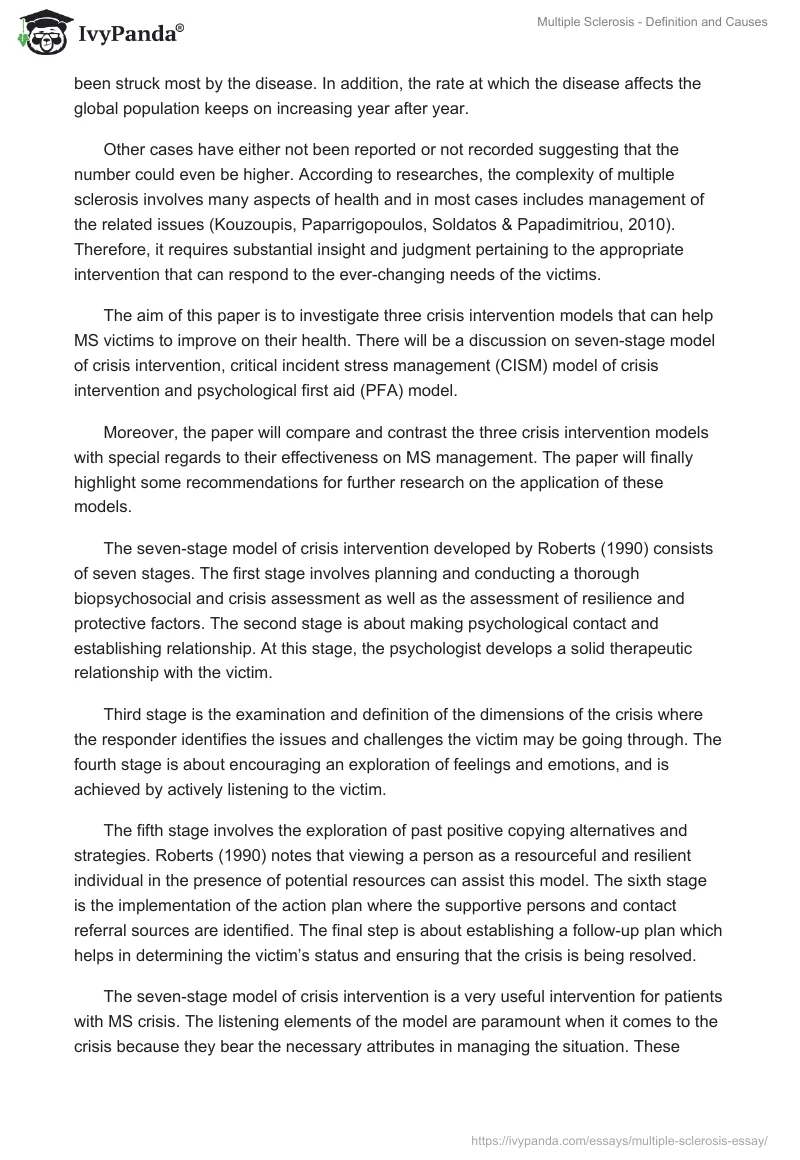Multiple Sclerosis
Multiple sclerosis (MS) is a significant crisis due to the fact that many people have suffered from the disease without getting proper support from clinical strategies applied. This is a disease which consumes the healthy body tissues that support life. Moreover, the disease affects the brain to the extent of the victim losing the larger part of his conscious mind. These facts were the major forces that led to the selection of the ailment as my crisis.
I have encountered many individuals whose healthy states have been devastated by the ailment. It is well understood that MS can be intervened effectively and prevent consequences that relate much to the behavioral and psychological changes in a patient. Evidence from studies suggests that psychological intervention can greatly improve the health and reduce negative impacts of MS especially if the appropriate model is employed (Rigby, Thornton & Young, 2008).
The crisis resulting from MS is a big challenge and a major concern for the welfare of the people. Very many families have been denied the pride of living with resourceful members. Likewise, the economy has lost significant people to the ailment as well as many contributors becoming a burden to the families they are supposed to support.
Young and energetic workers have become economically dependent as a result of the disease. Every state has been looking for ways to prevent these great losses. As a matter of fact, the society perceives the ailment as one of the economic challenges that must be resolved regardless of the cost incurred as people with the disease are more likely to be unemployed.
The crisis is therefore a major drawback towards the economic success of most people at family level. Young people have been affected most when compared to other members of the society. In particular, workers in jobs that demand physical input have been struck most by the disease. In addition, the rate at which the disease affects the global population keeps on increasing year after year.
Other cases have either not been reported or not recorded suggesting that the number could even be higher. According to researches, the complexity of multiple sclerosis involves many aspects of health and in most cases includes management of the related issues (Kouzoupis, Paparrigopoulos, Soldatos & Papadimitriou, 2010). Therefore, it requires substantial insight and judgment pertaining to the appropriate intervention that can respond to the ever-changing needs of the victims.
The aim of this paper is to investigate three crisis intervention models that can help MS victims to improve on their health. There will be a discussion on seven-stage model of crisis intervention, critical incident stress management (CISM) model of crisis intervention and psychological first aid (PFA) model.
Moreover, the paper will compare and contrast the three crisis intervention models with special regards to their effectiveness on MS management. The paper will finally highlight some recommendations for further research on the application of these models.
The seven-stage model of crisis intervention developed by Roberts (1990) consists of seven stages. The first stage involves planning and conducting a thorough biopsychosocial and crisis assessment as well as the assessment of resilience and protective factors. The second stage is about making psychological contact and establishing relationship. At this stage, the psychologist develops a solid therapeutic relationship with the victim.
Third stage is the examination and definition of the dimensions of the crisis where the responder identifies the issues and challenges the victim may be going through. The fourth stage is about encouraging an exploration of feelings and emotions, and is achieved by actively listening to the victim.
The fifth stage involves the exploration of past positive copying alternatives and strategies. Roberts (1990) notes that viewing a person as a resourceful and resilient individual in the presence of potential resources can assist this model. The sixth stage is the implementation of the action plan where the supportive persons and contact referral sources are identified. The final step is about establishing a follow-up plan which helps in determining the victim’s status and ensuring that the crisis is being resolved.
The seven-stage model of crisis intervention is a very useful intervention for patients with MS crisis. The listening elements of the model are paramount when it comes to the crisis because they bear the necessary attributes in managing the situation. These elements include attending, understanding and responding to the crisis with empathy, respect, genuineness, acceptance and caring.
Equally important are the action stages when conducted in a collaborative and nondirective approach, which responds to the assessed needs of the patient with MS as well as ensuring that the environment supports the intervention. Kouzoupis, Paparrigopoulos, Soldatos and Papadimitriou (2010) insist that the most effective crisis intervention should consider the support provided by the environment in which the patient is in.
The critical incident stress management (CISM) model of crisis intervention developed by Everly and Mitchell has been applied with significant success. This model is embedded on three ideas and includes potentiating pairings, catalytic progressions and polythetic nature. The use of interacting combination of interventions to attain an enhanced clinical effect is what is referred to as potentiating pairings.
Catalytic progression is the methodical combination of premeditated interventions to make best use of the clinical effectiveness. On the other hand, polythetic nature of the model stands for the selection of premeditated interventions as described by the specific needs of each crisis state. Therefore, the interventions within this model are integrated and sequenced in a way that achieves the most efficient intervention possible. The different combinations that are used in this model are determined by the particular requirements of each crisis.
As noted in this crisis, MS is associated with many difficult situations especially for a married man who is the economic pillar of the family. This places CISM model of crisis intervention as an effective tool in the MS crisis intervention. The many issues that lead to psychological trauma due to the crisis may as well require potentiating parings as the initial stage towards intervention.
Rigby, Thornton and Young (2008) note that patients with MS are not as responsive as it may be required during an intervention. Hence, deliberate interventions as defined by the needs of the patients can be very effective in solving psychological issues affecting the man and his family especially when the environment offers psychological and social support.
Psychological First Aid (PFA) model has been supported by many medical bodies including the Institute of Medicine. This support is greatly embedded on the major goals of the model. First, the model is intended to provide information and education about the issues surrounding the specific crisis.
Second, the model is aimed at comforting and peer supporting. The third goal is the acceleration of recovery while another one is the promotion of resiliency and mental health. PFA is also intended to offer access to continued care which makes it to be seen as a kind of emotional first aid. PFA intervention involves five stages unlike the seven-stage model: the assessment stage, stabilization stage, triage stage, communication stage and the connection stage.
For multiple sclerosis, PFA can be designed to reduce apprehension through nondirective listening and reassuring the patient. There are high chances of the patient diagnosed with multiple sclerosis experiencing trauma. Researches point that people diagnosed with multiple sclerosis will certainly suffer from psychological distress especially if the crisis is diagnosed late. PFA is a proper intervention in that it will build family resilience in the presence of the financial constraints and form a strong basis of managing the crisis.
The family in particular will experience positive coping and ability to help the patient to acquire the best clinical attention. As Stathopoulou, Christopoulos, Soubasi and Gourzis (2010) observe, the ability to solve traumatic problems collectively is an important element in healing trauma.
The three models suggested in this crisis have notable similarities and differences. For the similarities, the models suggest a kind of progressive or developmental approach. For instance, the models support stepwise actions that are defined by the changing needs of the patient with multiple sclerosis. Moreover, the three models call for collaborative efforts during the implementation of crisis intervention strategies.
For instance, the seven-step model and CISM model emphasize on the collaborative learning of the environment within which the patient lives in order to ensure the necessary assessment of the particular needs of the patient. Finally, the models focus on the psychological problems experienced after the member of the family suffers from multiple sclerosis.
Nonetheless, the three models have differences embedded on the manner in which each model is applied. The seven-step model emphasize on seven distinctive phases of crisis intervention while the PFA model can be summarized in five general stages. The CISM model on the other hand identifies three general stages of intervention.
In addition, The CISM model emphasizes on combining deliberate interventions while the other two are more systematic with weights on progressive learning and response to the changes occurring in the patient. It can be argued that the PFA model has a special focus on emotional wellness of the victim while the other two models consider both social and emotional fitness of the patient.
Due to the fact that the three models have few limitations on their effectiveness, there is need for further research. MS crisis is characterized by factors that are beyond situational control such as loss of a job or inability to communicate properly. The extent to which these factors heighten the crisis is not well understood.
Stathopoulou, Christopoulos, Soubasi and Gourzis (2010) are of the opinion that many crisis interventions ignore some important personality characteristics such as the attitude of both the patient and family members. Therefore, the identification of the core factors through research could be a good way of developing effective intervention strategies for the crisis intervention models.
In conclusion, MS is a persistent crisis that has ruined the lives of many individuals and families. Nonetheless, there is hope of managing the crisis better especially if there is collective input. The point here is not only to treat the disease, but to help members of the society to cope positively with difficult situations arising.
References
Kouzoupis, A. B., Paparrigopoulos, T. Soldatos, M. & Papadimitriou, G. (2010). The family of the multiple sclerosis patients: a psychosocial perspective. International Review of Psychiatry. 22(1), 83-89.
Rigby, S. A., Thornton, E. W. & Young, C. A. (2008). A randomized group intervention trial to enhance mood and self-efficacy in people with multiple sclerosis. British Journal of Health Psychology. 13(4), 619-631.
Roberts, A. R. (1990). Crisis intervention handbook: assessment, treatment and research. Belmont, CA: Wadsworth.
Stathopoulou, A., Christopoulos, P., Soubasi, E. & Gourzis, P. (2010). Personality characteristics and disorders in multiple sclerosis patients: assessment and treatment. International Review of Psychiatry. 22(1), 43-54.

